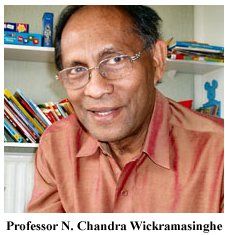by GLR Professor N. Chandra Wickramasingh
It is not often scientists are willing to openly discuss the possibility of extraterrestrial life.
According to a famous astronomy professor there is a reason why a majority of scientists avoid the subject - it is censored!
Even though the general public embraces ideas of extraterrestrial life, science is expected to shun this subject no matter how strong the evidence, albeit through a conspiracy of silence.
It is an unwritten doctrine of science that extraterrestrial life could not exist in our immediate vicinity, or, that if such life did exist, it could not have a connection with Earth.
Professor N. Chandra Wickramasinghe was born in Colombo, Sri Lanka, on January 20, 1939.
He studied astrophysics at Cambridge, where he was a student of Hoyle's.
He received his Ph.D. in 1963 and an Sc.D. in 1973, and served on the faculty at Cambridge. He is now a Professor of Applied Mathematics and Astronomy at the University College, Cardiff, Wales. He is an expert in the use of infrared astronomy to study interstellar matter.
"My own personal involvement in this matter dates back to the 1970's when, together with the late Fred Hoyle, I was investigating the nature of interstellar dust.
At this time evidence for organic molecules in interstellar clouds was accumulating at a rapid pace, and the interstellar dust grains that were hitherto believed to be comprised of inorganic ices were shown by us to contain complex organic polymers of possible biological provenance.
These discoveries came as a surprise to astronomers, and for a long time the conclusion was resisted that such molecules might have a relevance to life on the Earth," says professor Wickramasinghe.
Hoyle and Wickramasinghe were among the first scientists to make a connection between complex organic molecules in interstellar clouds and life on Earth.
"My first inkling of any censorship relating to extraterrestrial life came when we made the intellectual leap from prebiology in space to fully-fledged biology outside the Earth."
In setting out to explore the hypothesis that interstellar grains were not just abiotic organic polymers but bacterial cells in various stages of degradation, we made a prediction that interstellar dust in the infrared spectral region must have the signature of bacteria.
Infrared sources near the galactic centre were a prime target for this investigation and on our instigation approaches were made to the Anglo-Australian telescope committees to provide time on the AAT to test our seemingly wild hypothesis.
An application for observing time for this project made by my brother Dayal T. Wickramasinghe at ANU and David Allen was duly refused as "having no scientific value," explains professor Wickramasinghe. "After 1982, when evidence for cosmic life and panspermia acquired a status close to irrefutable, publication avenues that were hitherto readily available became suddenly closed.
With the unexpected discovery that comets had an organic composition, with comet dust possessing infrared spectra consistent with attitudes hardened to a point that panspermia and related issues were decreed taboo by all respectable journals and institutions."
Wickramasinghe believes that this campaign of explicit denials and censorship may have started between 1962 and 1965 when microorganisms were actually recovered from the stratosphere using balloons flown to heights between 20 and 43km.
"This important pioneering work, carried out by NASA at the dawn of the Space Age, probably rang alarm bells to which the authorities had to react, and react they surely did.
I was told by Leslie Hale, an atmospheric scientist at Penn State University that this exciting programme of work was suddenly halted by funds being withdrawn. Nothing more was said," says professor Wickramasinghe.
When Hans Dieter Pflug, a colleague of professor Wickramasinghe investigated the Murchison meteorite, he discovered a wide range of organic structures uncannily similar to terrestrial microorganisms
Hans Pflug was invited to Cardiff and gave a lecture, introduced by Fred Hoyle, that left the audience speechless. Pflug was not attacked on grounds of contamination or artifacts, but he was given what could be described as the "silent treatment".
Richard B Hoover's recent reexamination of Murchison meteorite microfossils confirms Hans Pflug's discoveries.
"Using state of the art technology Hoover concludes that microbial fossils unambiguously exist in great profusion. The furore that greeted this new publication, with vocal condemnation from Science journals and from NASA chiefs, shows that earlier tactics of rejection by silence have now been replaced by strident ranting and even personal insults.
Had we lived in the Middle Ages there is no doubt that Richard B Hoover, and possibly Fred Hoyle, Pflug, and I too, would have come to a bad end - suffering the fate of Giordano Bruno in 1600!", says professor Wickramasinghe
Is there life on other planets? People would like to know, but scientists are not talking.
"Even though the general public revelled in ideas of extraterrestrial life, science was expected to shun this subject no matter how strong the evidence, albeit through a conspiracy of silence.
It was an unwritten doctrine of science that extraterrestrial life could not exist in our immediate vicinity, or, that if such life did exist, it could not have a connection with Earth, continues professor Wickramasinghe.
Professor Wickramasinghe's was recently dismissed from his post and criticized for his support of Hoover's alien life claim.
It should be added that professor Wickramasinghe's research dealt only with extraterrestrial microbial life. One can imagine what would happen if scientists suddenly started to debate in public issues concerning the existence of advanced, intelligent extraterrestrial life.
Resisting the facts and imposing censorship will in the long run turn out to be futile.
The Universe will always have its last say.


